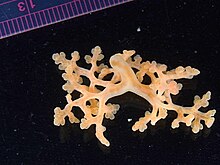Ascothoracida
| Ascothoracida | |
|---|---|

| |
| A member of the Dendrogaster genus | |
| Scientific classification | |
| Domain: | Eukaryota |
| Kingdom: | Animalia |
| Phylum: | Arthropoda |
| Class: | Thecostraca |
| Subclass: | Ascothoracida Lacaze-Duthiers, 1880 [1] |
| Orders and families [2] | |
|
Dendrogastrida Grygier, 1987
Laurida Grygier, 1987
| |
Ascothoracida is a small group of parasitic marine crustaceans, comprising around 100 species and divided into Dendrogastrida and Laurida.[3] They are found throughout the world on cnidarians and echinoderms.[4] Dendrogastrida are parasites on echinoderms, and Laurida are parasites on cnidarians, except from the species Waginella Grygier, which is also a parasite on echinoderms (crinoids). Piercing and sucking mouthparts are used for feeding, and more advanced forms also absorb nutrients through a modified integument of the carapace. More basal forms are ectoparasitic, but most genera are meso- and endoparasitic. The sexes are separate, except from secondary hermaphroditic species of the Petrarcidae. In many species the larger female often have smaller males living inside her mantle cavity.[5][6]
Ascothoracida was previously ranked as an order within the infraclass Cirripedia (barnacles), but now both Ascothoracida and Cirripedia are considered separate subclasses. Those two subclasses, along with Facetotecta, make up the class Thecostraca.[2][7][8]
The thorax of Ascothoracida species has six pair of biramous appendages, while the abdomen has four segments and a terminal telson with a caudal furca.[9] This arrangement is similar to that seen in copepods.[9] In addition, there is a bivalved carapace, which is expanded in females.[9]
References
[edit]- ^ "Ascothoracida Lacaze-Duthiers, 1880". Integrated Taxonomic Information System. Retrieved December 8, 2010.
- ^ a b Joel W. Martin & George E. Davis (2001). An Updated Classification of the Recent Crustacea (PDF). Natural History Museum of Los Angeles County. pp. 132 pp. Archived from the original (PDF) on 2013-05-12. Retrieved 2009-12-31.
- ^ Paul Schmid-Hempel (2011). "The diversity and natural history of parasites". Evolutionary Parasitology: the Integrated Study of Infections, Immunology, Ecology, and Genetics. Oxford University Press. pp. 18–51. ISBN 978-0-19-922949-9.
- ^ J. K. Lowry (October 2, 1999). "Ascothoracida (Thecostraca, Maxillipoda)". Crustacea, the Higher Taxa: Description, Identification, and Information Retrieval. Australian Museum. Archived from the original on February 24, 2012. Retrieved December 31, 2009.
- ^ Parasitic Crustacea: State of Knowledge and Future Trends
- ^ Atlas of Crustacean Larvae
- ^ Chan, Benny K. K.; Dreyer, Niklas; Gale, Andy S.; Glenner, Henrik; et al. (2021). "The evolutionary diversity of barnacles, with an updated classification of fossil and living forms". Zoological Journal of the Linnean Society. 193 (3): 789–846. doi:10.1093/zoolinnean/zlaa160. hdl:11250/2990967.
- ^ "World Register of Marine Species, subclass Ascothoracida". Retrieved 2021-08-22.
- ^ a b c D. R. Khanna (2004). "Segmentation in arthropods". Biology of Arthropoda. Discovery Publishing House. pp. 316–394. ISBN 978-81-7141-897-8.
External links
[edit] Data related to Ascothoracida at Wikispecies
Data related to Ascothoracida at Wikispecies
